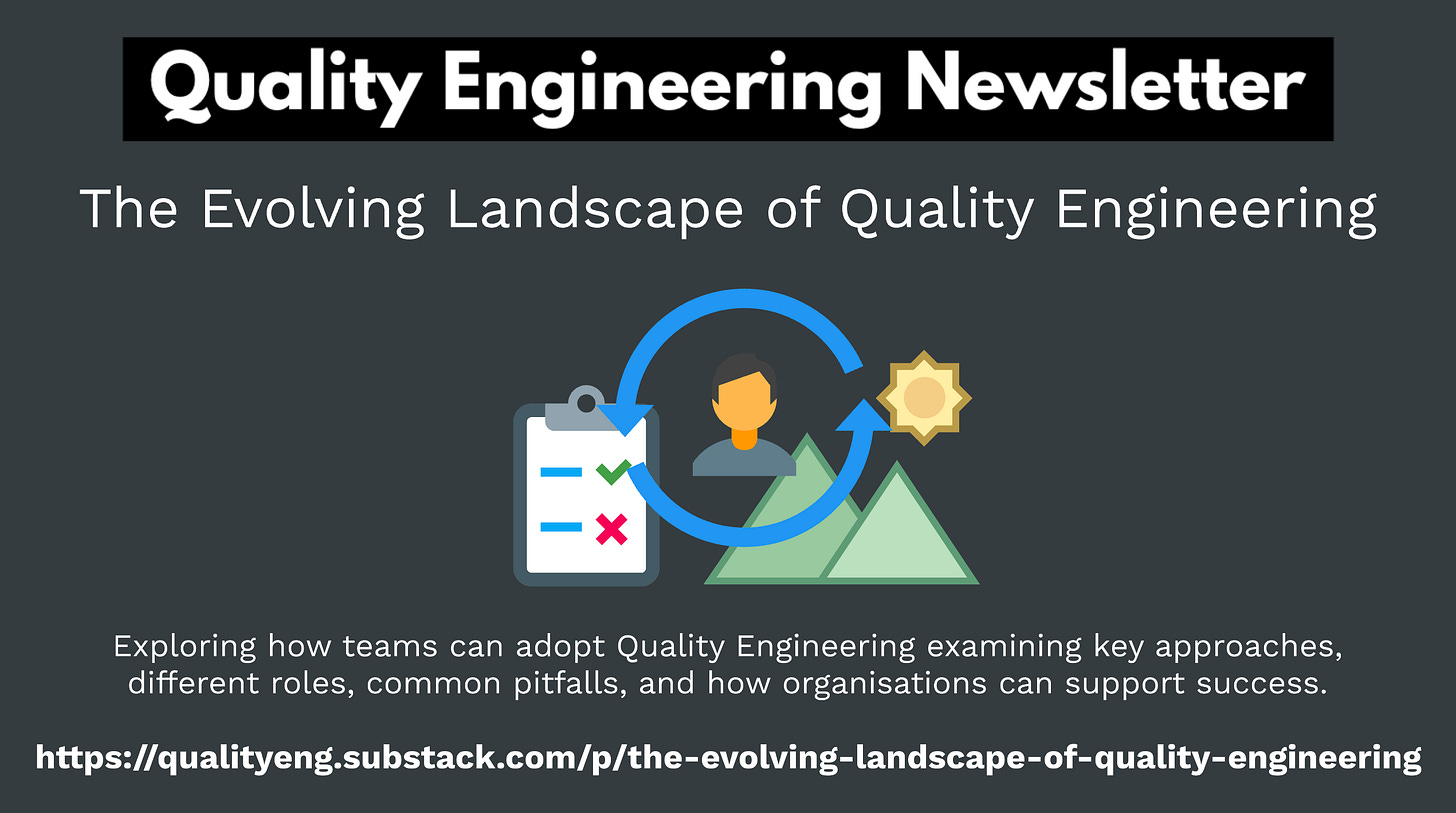
The Evolving Landscape of Quality Engineering
Quality engineering (QE) is gaining traction across engineering teams, reshaping how we approach software quality. Recently, I had the opportunity to participate in a panel discussion where we explored how teams are adapting to QE, how testing is evolving, and the roles, pitfalls, and organisational support needed for success. Below are my key takeaways.
How Are Teams Approaching Quality Engineering?
One of the biggest misconceptions about QE is that it requires teams to abandon their existing practices. In reality, it’s about identifying what works and building on it. Most teams have good practices in place, but they may not have previously framed them within a quality engineering mindset.
A good starting point is helping teams understand how their current processes contribute to quality and then expanding from there. This could mean:
Inspecting for quality at different layers of the system.
Reframing testing as uncertainty reduction to identify additional opportunities for improvement.
Tackling current team challenges with a QE mindset—understanding how problems connect to quality, which stakeholders benefit, and how improvements can be measured.
Quality engineering isn’t just about technical practices, it’s about fostering a culture of learning and experimentation. By encouraging a systems thinking approach, teams can move beyond isolated optimisations and see how the whole is greater than the sum of its parts.
Learn more
The six layers of testing detail the different layers and the types of testing involved.
The Uncertainty of Change discusses reframing testing as uncertainty reduction and finding new ways to reduce it. The Quality Engineering Newsletter: Where to Start is a good starting point for developing a better understanding of quality engineering.
How Does Testing Evolve in a Quality Engineering Approach?
A shift towards QE doesn’t mean testing becomes obsolete. Testing remains a crucial method of inspecting for quality at any given moment. However, it no longer has to happen at the end of the development process.
Instead, QE reframes testing as a feedback mechanism. This broadens the scope beyond traditional manual and automated testing to include:
Monitoring and observability tools that provide real-time insights.
Various feedback loops integrated throughout the development lifecycle.
A broader range of team members engaging in quality activities.
Testers still play a critical role, often serving as specialists in quality inspection. However, QE offers testers new pathways, expanding their focus from defect detection to shaping the quality of systems and services at a fundamental level.
Learn more
The Testing Unknown Unknowns introduces the idea of testing being about feedback and how the unknowns help us understand where our uncertainty is. Exploring the Limits of Testing in Software Systems takes the idea of testing unknown unknowns a step further and helps us to understand how change affects our uncertainty in how systems behave and what testing does to help reduce it.
Quality Engineering Newsletter is a reader-supported publication. To receive new posts and support my work, consider becoming a free or paid subscriber.
The Roles Within Quality Engineering Teams
While developers and testers are the most commonly associated roles in QE, many other roles contribute to building quality in:
Developers are best placed to integrate quality directly into the code, provided they have the right information.
Testers help bridge knowledge gaps and contextualise changes within the broader system.
Designers bring usability and accessibility perspectives.
Product managers provide business and organisational context.
Business analysts understand how new work fits within existing processes.
Delivery managers help teams balance immediate needs with long-term quality goals.
Agile coaches facilitate continuous improvement and learning.
The beauty of QE is its flexibility. Some teams adopt it as a philosophy that aligns multidisciplinary efforts. In contrast, others focus more on frameworks, practices, or specific tools and techniques.
Learn more
In Who Should Build a Culture of Quality, I detail how different roles help build quality in and techniques they can use to leverage their skills.
Common Pitfalls in Adopting Quality Engineering
Teams often fall into traps when transitioning to QE. Some of the most common ones include:
Simply renaming testers to “Quality Engineers” without meaningful change.
Assuming “building quality in” eliminates the need for manual testing.
Thinking QE is solely a developer’s responsibility.
Over-focusing on end-user experience while neglecting system-level quality.
Assuming hiring QE specialists guarantees success.
Expecting zero failures after adopting QE.
Making quality “everyone’s responsibility” automatically builds a quality culture.
Avoiding these pitfalls requires a clear understanding of QE, which involves integrating quality into every development aspect rather than treating it as a separate function.
Learn more
The Common Misconceptions About Quality Engineering expands on these myths and how to address them.
How Can Organisations Support Quality Engineering?
For QE to thrive, organisational support must exist at all levels:
Senior leadership (Heads of, Directors) sets the vision—where the organisation is headed and why quality matters.
Mid-level leadership (Engineering/Test Managers, Team Leads) determines how teams will execute that vision.
Individual contributors (Developers, Testers, Product Managers, UX, etc.) implement quality practices in their day-to-day work.
Explicitly embedding quality into the organisational vision signals its importance. Too often, quality is assumed rather than actively discussed. A strong quality culture is inseparable from a learning culture—an environment that encourages continuous improvement and experimentation leads to resilient, high-quality systems.
Learn more
Quality Engineering as philosophy, a framework and a tool goes into detail about how each of these levels helps build quality in.
Final Thoughts
Quality engineering isn’t just about testing or tools, it’s about fostering a mindset that integrates quality into every aspect of software development. By embracing a holistic, systems thinking approach and supporting teams at all levels, organisations can build not just high-quality software but a culture that sustains it.
Thanks for reading Quality Engineering Newsletter! This post is public so feel free to share it.

